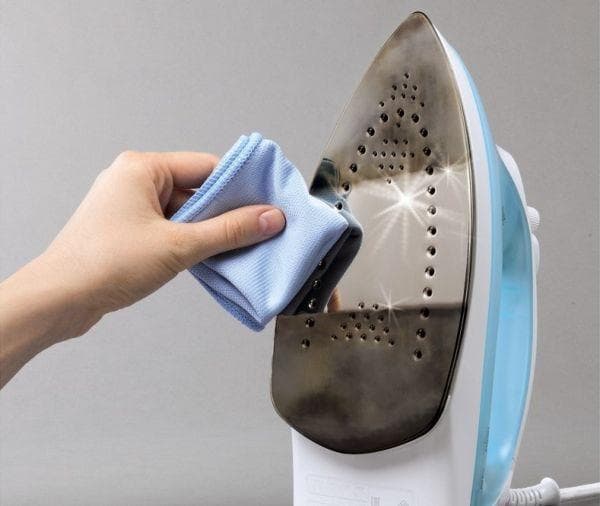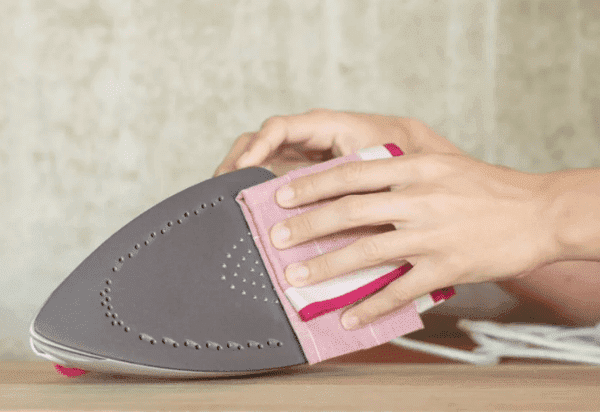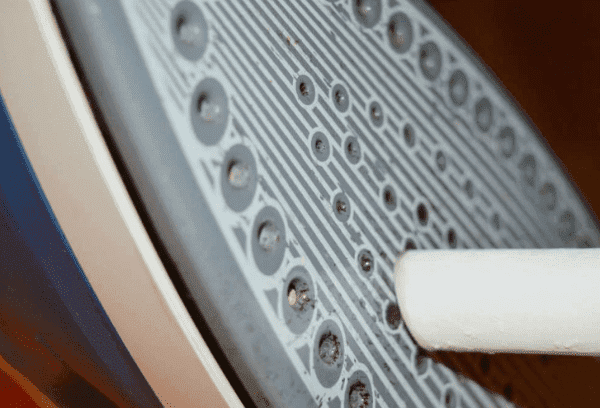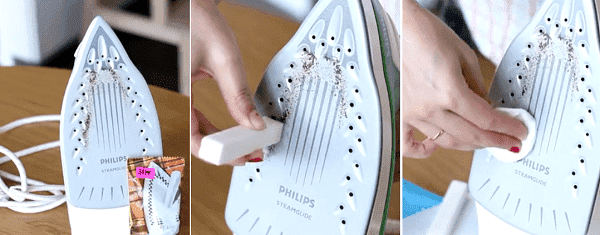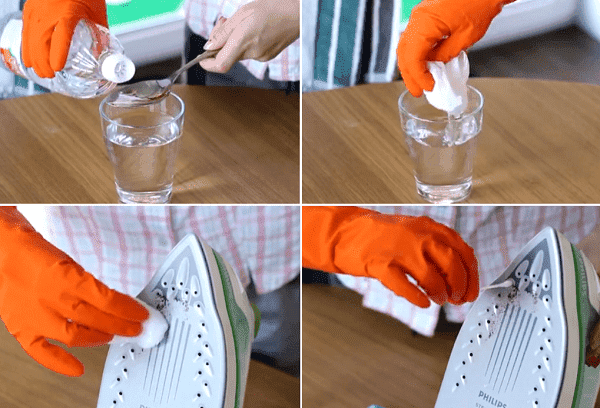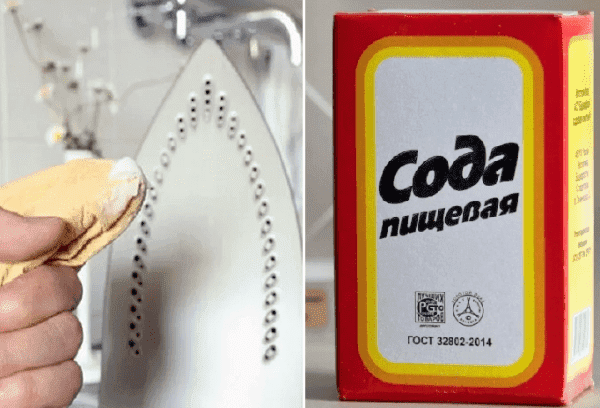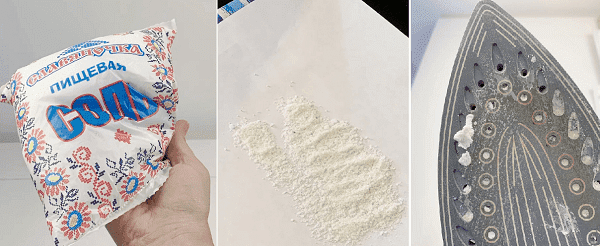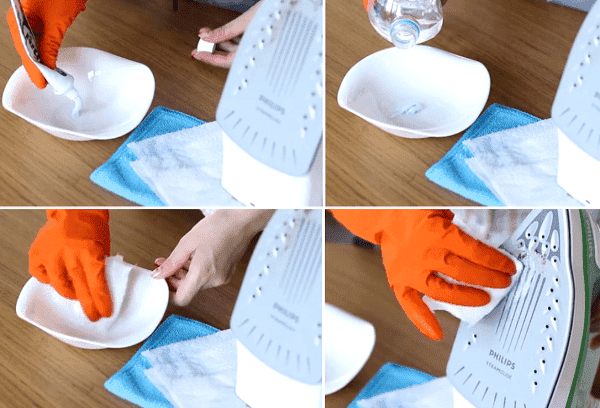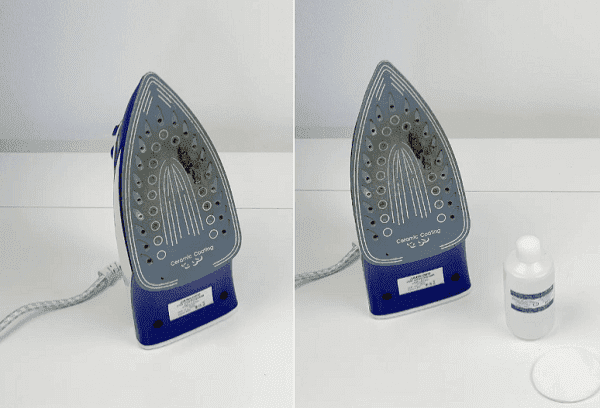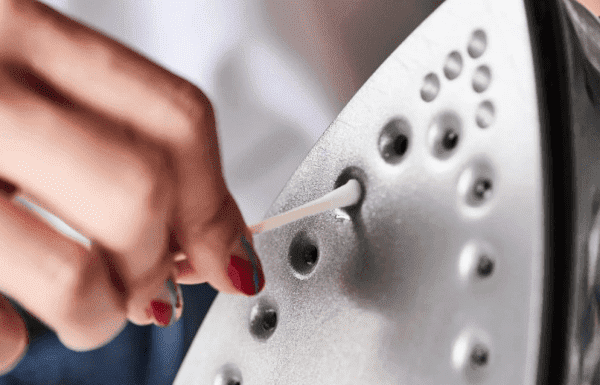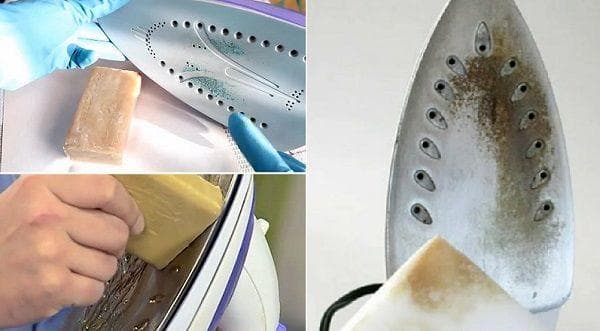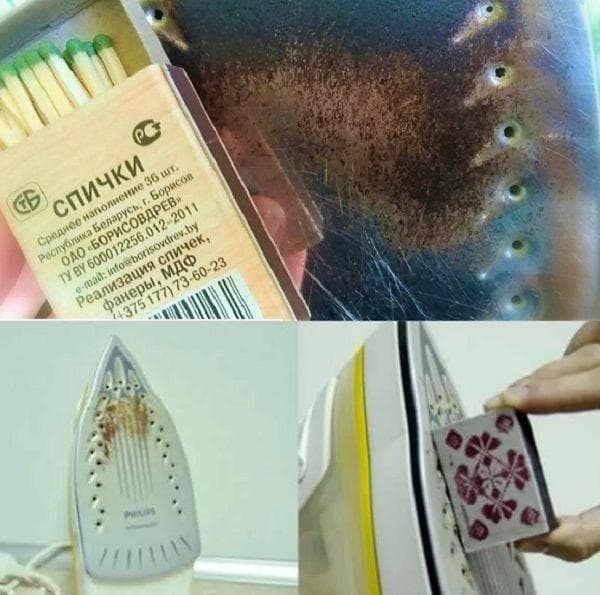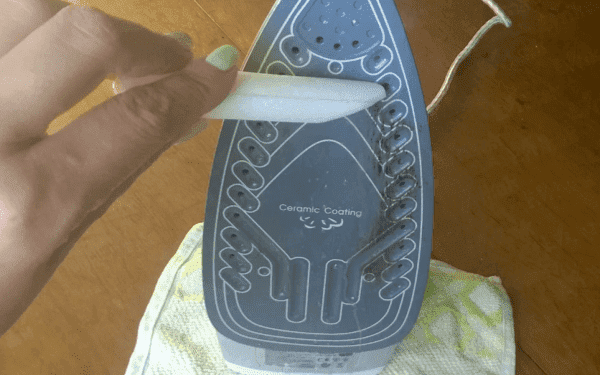Quickly getting rid of carbon deposits: how to clean an iron without damaging the sole
Content:
If you ruin your favorite item while ironing, don’t hesitate. It is important to clean the iron from carbon deposits as quickly as possible. At home, it is convenient to use a special pencil to clean the soles. It removes any dirt in seconds and is suitable for both old and new models. There are other ways to remove carbon deposits - traditional ones.
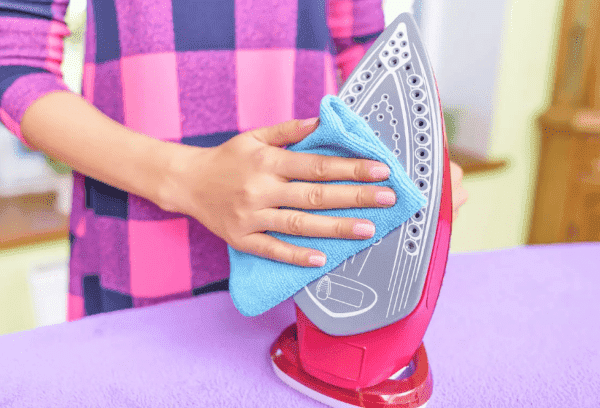
Material
Today, irons are produced with different functions and coatings - ceramic, titanium, Teflon, with aluminum and stainless steel soles. But even the most “fashionable” and ultra-modern iron can suffer if it is not properly cared for.
Modern materials can be easily cleaned of carbon deposits if you use the right approach.
Ceramic sole
The ceramic iron seems to “float” across the fabric. Incredibly easy to glide, it is also low maintenance. Carbon deposits can be removed with almost any chemical means.Ceramics are only afraid of chips, sudden temperature changes and sharp objects. It is recommended to use a wooden spatula instead of scrapers and brushes.
Stainless steel sole
Stainless steel does not scratch. It can be easily cleaned with abrasive powders, alkalis, acids, and salt. The carbon deposits come off well and quickly, especially when the sole is hot.
Aluminum soles
The most common option on the market. Irons with aluminum soles are lightweight, maneuverable, and heat up instantly. However, the sole must be cleaned with great care. Aluminum is quite soft and can be deformed. It cannot be cleaned with acid, alkali, or scratched with sharp objects. You can use toothpaste, soap, and wax to clean carbon deposits.
Teflon coating
Thanks to the Teflon coating, the iron glides well. Teflon soles can be cleaned from carbon deposits with acid, hydrogen peroxide, and acetone. Do not use abrasive powders or sharp scrapers. The Teflon layer is thin. If you scratch it, the device will begin to “catch” the fabric when ironing.
Enameled coating
Models of irons with enamel coating are among the most high-tech. They are not afraid of scratches, chips, acids and alkalis. You can clean the sole with soda, vinegar, toothpaste, soft steel wool, and store-bought cleaners.
Titanium coating
The most wear-resistant and durable coating is titanium. It cannot be scratched or damaged in any other way. You can remove carbon deposits with chemicals, a metal sponge, and whatever is at hand.
How to clean an iron from carbon deposits using store-bought products?
In every hardware store you can find products for cleaning the soleplate of an iron: pencils, liquid cleaners, napkins, mats. Their prices are affordable.For example, the cost of a pencil is 20-60 rubles.
Store-bought products contain strong chemicals. They quickly, effectively and carefully remove carbon deposits without damaging the surface of the sole.
All these products are easy to use at home. The packaging contains detailed instructions.
Cleaning pencil
The most popular, affordable option. All pencils for cleaning carbon deposits have the same composition: organic acid and urea or other additives. They are used for so-called “hot cleaning”.
Cleaning the sole:
- Heat the iron to 140 degrees.
- Install vertically.
- Draw circles on the sole with a pencil.
- The pencil begins to instantly melt, corroding the carbon deposits.
- Iron the cotton rag.
- The sole is sparkling clean!
Liquid products
Liquid cleaners are mostly designed for cleaning irons with a steam function. They are poured inside the device to remove scale. But you can clean the sole with liquid. It will also corrode the carbon deposits. The spot is lubricated, after which the device is heated to 100-140 degrees, turned off, and waited for 10 minutes. The dirt becomes soft and can be easily wiped off with a rag.
Cleaning wipes
Special wipes for cleaning irons have two sides: hard for removing plaque on the sole, and soft for polishing. They are able to remove fresh carbon deposits and are also useful for everyday cleaning.
Cleaning mats
A relatively recent invention is the POLYFER Laurastar cleaning mat. It is installed on the ironing board. If the sole becomes dirty, rub the cold iron against the mat and then wipe it with a damp cloth. The surface becomes perfectly clean. True, the rug is not cheap - about 3,000 rubles.
How to clean an iron from carbon deposits using improvised means?
It often happens that carbon deposits on the sole appear suddenly, and there are no special cleaning products at hand. You don't have to stop ironing and run to the store. Fresh plaque can be removed with soap, toothpaste, vinegar, soda, and peroxide. The list of folk recipes is extensive.
Vinegar
To clean the iron, use 9% table vinegar. It softens carbon deposits and promotes better removal from the sole. Apply vinegar to the cold surface. Then the device is heated and the coarse fabric (rags) is ironed.
If there is a lot of soot, you can moisten a napkin with vinegar, put it on the table, and place a warm iron on top. After 2-3 hours, the hard crust will fall off on its own. The method is suitable for all irons.
Soda
Baking soda will help remove small reddish spots on the soles. It should be diluted with water to a thick paste. Apply a cloth to the stain and rub. If it doesn't come off, wait 10 minutes and try again.
You can moisten a sponge with vinegar. A violent reaction will occur, causing the carbon deposits to peel off. At the end, you need to wipe the surface with a damp cloth and iron it with some rags.
Salt
The old-fashioned way. Previously, the iron was cleaned from carbon deposits only with salt. They did it like this:
- Spread a thick layer of coarse table salt on the newspaper.
- The iron was heated.
- “Stroked” the salt for 5-10 minutes.
All carbon deposits were cleaned off using large crystals. Sometimes salt was mixed with grated paraffin. The wax further polished the sole. Nowadays, the salt method is practically not used.
Salt leaves scratches on modern coatings (exceptions are titanium and stainless steel).
How to clean an old Soviet iron with salt:
Toothpaste
A simple white toothpaste (not gel) can remove carbon deposits from your iron. It is applied with a soft brush and left for 5 minutes.Then rub the surface well and wash with a damp sponge. Toothpaste can be used to clean any coating: Teflon, ceramic, titanium. But it will not cope with severe pollution.
Hydrogen peroxide
A 3% solution of hydrogen peroxide gently cleans the soleplate of the iron. The device is first heated to 100 degrees and turned off. Peroxide is applied with a napkin or ear stick. After 1-3 minutes, remove the deposits with a hard cloth.
Acetone (nail polish remover)
The caustic liquid does not react with Teflon and ceramics, and at the same time effectively removes carbon deposits formed from melted synthetics and oilcloth. You need to moisten a cloth with acetone and wipe the stain off the cold sole. When the carbon deposits disappear, the remaining chemicals should be removed with a damp cloth.
Laundry soap
A bar of laundry soap should be moistened with water and rubbed on the cold sole. Heat the iron to 100 degrees. Switch off. Wait 5 minutes and wash off the soap and carbon deposits with a damp cloth. The method helps to remove fresh deposits, similar to rust.
Matchbox
An old method used by housewives 30-40 years ago. On new models it is better not to use it so as not to scratch the surface. The point is to remove carbon deposits with a strip of red phosphorus (on which matches are lit). The iron should be slightly hot. Then the plaque is removed well.
Paraffin candle
Wax can be used to clean any iron. It not only removes carbon deposits, but also polishes the sole. You need to turn on the heat to 100 degrees. Place the device at an angle above the paper. Place a paraffin candle on the hot surface. The melted wax will flow down, carrying with it burnt lint and dirt particles.
To prevent paraffin from clogging into the holes in the iron, you need to press the steam button several times before finishing cleaning. After cooling, remove the remaining wax with your fingers. Iron the rags with an iron.
Preventive measures
Almost always, carbon deposits on the sole of the iron are formed due to the carelessness of the owner. The device is forgotten to be turned on on clothing, or a delicate item is ironed at too high a temperature. The matter melts and sticks to the heated surface. That's why:
The main prevention of carbon deposits on an iron is attentiveness.
Need to:
- Do not leave a hot iron unattended.
- Place it exclusively on the leg.
- Set the temperature according to the type of fabric:
- If there are difficulties in identifying the fabric, iron it through gauze or a thin cotton napkin.
- Clean the appliance from scale every 1-3 months. Limescale increases the risk of carbon deposits. It contaminates the fabric and makes the sole rough.
- If possible, use special products to care for the iron: Anti-scale, cleaning pencil and others.
- Do not use metal scrapers, scourers, knives, sandpaper or other materials that can damage the coating.
Any dirt or damage to the sole increases the risk of carbon deposits. The iron should glide easily over the fabric.
Questions and answers
Why does carbon deposits need to be removed from the iron immediately?
You cannot use an iron with carbon deposits. It will leave persistent red stains on clothes. In addition, with each heating, the plaque will harden more and more and eat into the surface of the sole. The top layer may collapse.
How to clean carbon deposits with liquids without damaging the device?
The sole must not be soaked. When cleaning, it is directed face down.Do not turn the iron over until it is completely dry so that liquid does not penetrate inside through the steam holes.
Iron deposits are a common problem. It especially often forms on old, worn-out soles. Fortunately, cleaning irons today is more than simple. There is a huge selection of store-bought products that dissolve hard plaque in a matter of minutes. Traditional methods are much less effective than traditional methods. But they can help out in an unforeseen situation when the necessary chemistry is not available.
